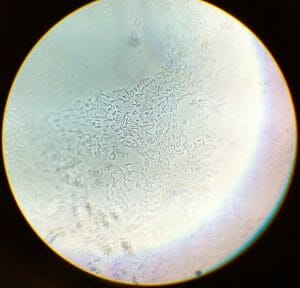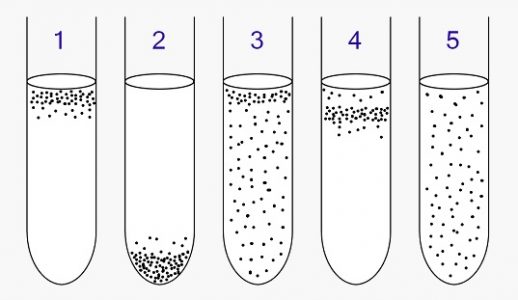Obligate Anaerobes Definition
Obligate anaerobes are organism which can only live in environments which lack oxygen. Unlike the majority of organisms in the world, these organisms are poisoned by oxygen. Obligate anaerobes are typically bacteria, and live in a variety of places naturally. Many obligate anaerobes live in the human body, in places like the mouth and gastrointestinal tract where oxygen levels are very low. Sometimes, these bacteria can accidentally be deposited where they are not supposed to be, causing serious infection. Some obligate anaerobes include the bacteria which cause gangrene and a number of other infections. Below is a microscope slide showing the Clostridium genus of bacteria, responsible for gangrene, tetanus, botulism, colitis, and other serious infections.

Why are Obligate Anaerobes Killed in Oxygen?
Unlike obligate aerobes, which require oxygen to survive, obligate anaerobes are actually poisoned by it. Unlike many organisms which thrive in oxygenated environments, obligate anaerobes do not have several key enzymes needed to detoxify oxygen in the cell. Oxygen itself, in the presence of water, produces several byproducts including hydrogen peroxide (H2O2). Hydrogen peroxide is a weak acid, and affects a number of enzymes within anaerobic cells. In high levels of oxygen, the cell becomes so acidic that it can no longer function.
This is why obligate anaerobes typically are only found in areas of little to no oxygen. At this level, their metabolic enzymes are not sufficiently hampered by the changes oxygen causes. Aerobic bacteria and eukaryotes have a number of defense mechanisms against oxygen. These include the enzymes superoxide dismutase, catalase, and peroxidase, which help deal with the byproducts of oxygen by keeping them as oxygen gas or making them into harmless water molecules.
Evolutionary Significance of Obligate Anaerobes
The existence of obligate anaerobes is a significant clue in the theory of the origins of life on planet Earth. While our atmosphere has a significant amount of oxygen now, that may not have always been the case. The presence of obligate anaerobes today suggests that the atmosphere once had much less oxygen, allowing bacteria to survive without oxygen facilitating enzymes. The theory suggests that with the rise of photosynthetic organisms, there also came a rise in the level of oxygen in the environment.
Where Obligate Anaerobes Exist
Today, the obligate anaerobes exist in many environments, all which have a defining quality of low oxygen levels. Many obligate anaerobes exist in the soil, away from the top layers which are highly exposed to oxygen. Other obligate anaerobes can be found in the gut, mouth, and reproductive tracts of animals. In these places, they is little to no oxygen because they are not exposed to blood vessels.
Sometimes, a severe infection can be caused when these bacteria get access to the sterile internal areas of the body. This typically happens when an organism is wounded, allowing the bacteria access to the normally closed-off areas. If the wound gets closed quickly and in a sterile manner, the bacteria will die in the presence of the oxygenated blood that gets to the area. If the wound does not have blood flow and is exposed to obligate anaerobes, it gives them a place to breed and grow. Many of these obligate anaerobes release toxins which destroy regular tissue. This caused the infection to get worse, and allows the bacteria to spread. Many infections caused by obligate anaerobes can be deadly if left untreated.
Finding Obligate Anaerobes
Obligate anaerobes can only be found in environments with low oxygen levels. In a world saturated by oxygen, this may seem like obligate anaerobes may be hard to find. But in fact, the opposite is true. Obligate anaerobes can be found in almost every environment, hidden away from expose to oxygen. To find the obligate anaerobes in any sample a simple experiment like the one below can be conducted.
The five images shown above represent where different types of bacteria can be found in a sample grown in a loosely capped test tube. The loose cap allows oxygen to saturate the top layer of the growth solution in the tube. Thus, image 1 represents the obligate aerobes, or the organisms which need oxygen. The obligate anaerobes, seen in image 2, are at the complete other side of the test tube.
At this end of the test tube, the oxygen concentration is the lowest. For one, it has to diffuse through the entire column of water to reach the bottom of the test tube. Without being disturbed or aerated in any way, the oxygen level will naturally be the lowest here. Further, the organisms in the tube which use oxygen will tend to congregate towards the top. These organisms will tend to deplete the oxygen within the test tube at all levels. This helps drive the oxygen gradient towards the top of the tube. Therefore, scientists searching for obligate anaerobes simply need to look in the most oxygen deprived portion of any sample. The other images (3-5) represent other kinds of bacteria, such as facultative anaerobes, which can survive in various conditions and may or may not need or use oxygen.
Quiz
1. The following is a list of bacteria and their main metabolic functions. Which of these are obligate anaerobes?
- A bacterium which uses oxygen to facilitate glucose metabolism
- A bacterium which tolerates oxygen, but does not use it in metabolism
- A bacterium which does not tolerate oxygen, and does not use it in metabolism
A. All of the above
B. 2 and 3 only
C. 3 only
2. A scientist takes a sample from the bottom of a nearby lake. He divides the sample into three test tubes. In the first test tube, he adds an air pump. In the second test tube, he seals the cap and removes the oxygen. The third tube he leaves unsealed, and undisturbed. Which tubes will NOT grow obligate anaerobes?
A. Tubes 1 and 3
B. Tube 1 only
C. Tube 2 only
D. Tube 3 only
3. Obligate anaerobes are often spore-forming, meaning that in times of stress the bacteria will store their DNA in a secured package which can whether environmental conditions. Why is it important that obligate anaerobes create spores capable of surviving conditions of high oxygen?
A. It is not important
B. These spores must survive oxygenated environments to colonize low-oxygen areas
C. These spores can use oxygen to help reproduce the bacteria
References
- Lodish, H., Berk, A., Kaiser, C. A., Krieger, M., Scott, M. P., Bretscher, A., . . . Matsudaira, P. (2008). Molecular Cell Biology (6th ed.). New York: W.H. Freeman and Company.
- University of Comenius. (2018, October 3). Anaerobic Bacteria. Retrieved from Jfmed.uniba.sk: https://www.jfmed.uniba.sk/fileadmin/jlf/Pracoviska/ustav-mikrobiologie-a-imunologie/ANAEROBIC_BACTERIA.pdf
- Widmaier, E. P., Raff, H., & Strang, K. T. (2008). Vander’s Human Physiology: The Mechanisms of Body Function (11th ed.). Boston: McGraw-Hill Higher Education.

